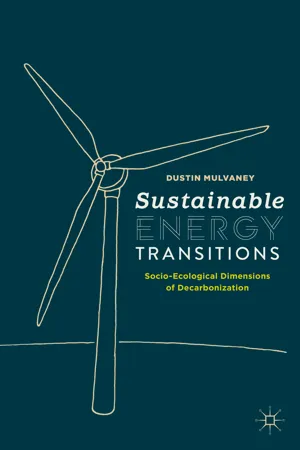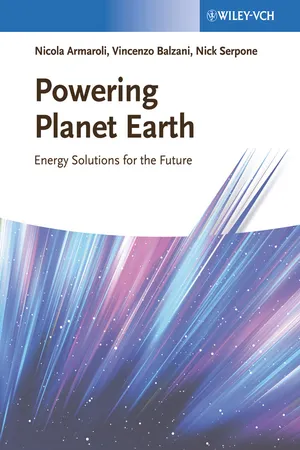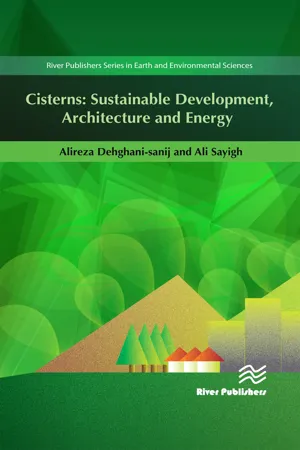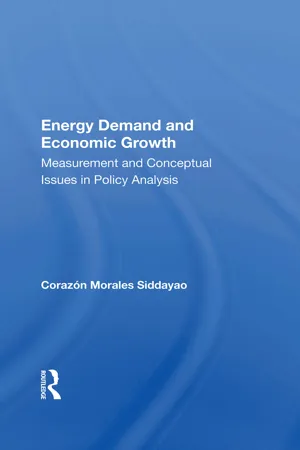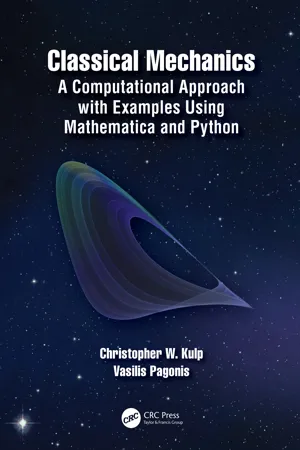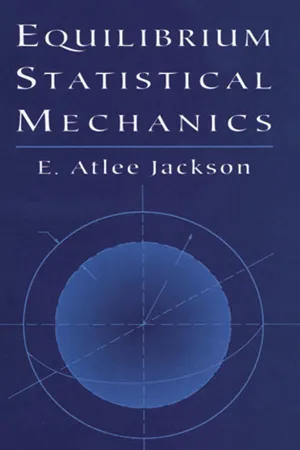Physics
Energy and the Environment
Energy and the environment are interconnected in the study of physics. The use and generation of energy have significant impacts on the environment, including air and water pollution, habitat destruction, and climate change. Understanding these interactions is crucial for developing sustainable energy sources and minimizing environmental harm.
Written by Perlego with AI-assistance
Related key terms
Related key terms
1 of 4
Related key terms
1 of 3
7 Key excerpts on "Energy and the Environment"
- eBook - ePub
Sustainable Energy Transitions
Socio-Ecological Dimensions of Decarbonization
- Dustin Mulvaney(Author)
- 2020(Publication Date)
- Palgrave Macmillan(Publisher)
Throughout this chapter, there are example problems that review energy-to-power relations, unit conversions, and stoichiometry, in addition to a handful of empirical problem sets and assignment. The chapter ends with a discussion about how concepts like entropy can provide a scientific basis for understanding how natural resource use has implications for intergenerational equality—the idea that resources must be managed for future generations (Costanza et al. 2014). 2.1 Power and Energy Energy is fundamental stuff. It is what allows life to occur, through metabolism and eventually decay. It shapes where non-living things are and where they are going. As the property of a star, the amount of energy determines whether humans could eventually inhabit those places. Energy also enables humans to develop the societies that exist today, and the linkages between peoples, economies, and nature in different parts of the world. Vaclav Smil describes energy use by human civilization as its metabolism—borrowing a metaphor for how living organisms process energy to fuel their needs and wants. What is energy? From your biology, physics, or chemistry classes in school you may recall that energy is the ability to do work or the ability to transform a system. Energy is encountered in different forms, but most often its presence is suggested by motion, activity, light, heat, or change. As a fundamental law of the universe, energy is always conserved. The energy that was present at the start of the universe is all still in the universe. This means energy cannot be created, only converted and transformed. Energy is a discrete quantity. This makes it different than power, which is a flow rate quantity of energy. Energy is the amount of power over time measured in joules (J) - eBook - ePub
- Michelle Addington, Daniel Schodek(Authors)
- 2012(Publication Date)
- Routledge(Publisher)
is flowing. The energy of motion that moves from high potential entities to low potential entities. Examples include water falling over a dam, a boulder rolling down a hill, the combustion of gasoline in an engine.Within these two classes, energy takes many different forms, and each form is characterized by a fundamental variable that becomes useful as energy only when difference comes into play. Without a difference between one state and another, energy cannot flow. As a result, energy can only be quantified and measured as it moves or by its potential to move.HEAT driven by temperature difference WORK driven by pressure difference POTENTIAL: driven by height difference ELECTRICAL: driven by charge difference KINETIC: driven by momentum difference ELASTIC: driven by deflection difference CHEMICAL: driven by atomic attraction differences NUCLEAR: driven by quanta differences MAGNETIC: driven by moving charge differences What, then, governs this movement? Although the flow of energy determines the behavior and state of all things – living and inanimate – scientists did not develop an understanding of it until 1850, two centuries after the establishment of Newtonian physics. The 19th century developments in steam engine technology finally led to the discovery of an important principle: the conservation of energy. This principle is perhaps the most fundamental building block of physics, and it is also the foundation for the branch of physics known as thermodynamics – the science of energy.3.2 Laws of thermodynamics
Derived from the Greek words thermé (heat) and dynamis (force), thermodynamics describes the branch of physics concerned with the conditions of material systems and the causes of any changes in those conditions. A material system may be comprised of anything from a solid to a liquid to a gas as well as a mixture thereof, but it is distinguishable as an identifiable quantity of matter that can be separated from everything else – the surroundings – by a well-defined boundary. The conditions of a system at any given moment are known as its state - eBook - ePub
Powering Planet Earth
Energy Solutions for the Future
- Nicola Armaroli, Vincenzo Balzani, Nick Serpone(Authors)
- 2012(Publication Date)
- Wiley-VCH(Publisher)
work .Broadly speaking, the ability to do work manifests itself in many ways; what we define as forms of energy go far beyond muscle energy described above. In their diversity, all forms of energy have one common feature: they are always the expression of a system that is capable of exerting a force, which can act against another force.We can easily locate seven forms of energy, almost all of which we experience daily:1)Thermal energy:radiators that heat our house.2)Chemical energy:natural gas that feeds our gas furnace and/or gas stove.3)Electrical energy:energy that makes electrical appliances work.4)Electromagnetic energy or light:sunlight that makes plants grow in a vase, on a balcony, or on a farm.5)Kinetic energy:energy of a glass bowl falling to the ground (gets broken).6)Gravitational energy:If the glass vase falls from a height of 10 centimeters (about 4 inches) it will likely not break, but if it falls from 2 meters (about 6.5 feet) there’s no hope of saving it.7)Nuclear energy:energy from the atom: difficult to see – we’ll have more to say on this later.The various forms of energy can then be converted from one form to another, but not always. For example, we can transform the Sun’s light energy into electricity through a solar panel. However, contrary to what is often thought, we cannot transform nuclear energy directly into electrical energy. Nuclear power plants are nothing more than sophisticated water kettles that convert nuclear energy into thermal energy, which in turn is converted into mechanical energy and then finally into electrical energy. - eBook - ePub
Cisterns
Sustainable Development, Architecture and Energy
- Alireza Dehghani-sanij, Ali Sayigh(Authors)
- 2022(Publication Date)
- River Publishers(Publisher)
The quality of energy varies from one kind to another, i.e. some kind of energies has a better quality like electrical energy, chemical energy, and nuclear energy, whereas ocean’s heat energy and molecular energy have a lower quality [2]. Several factors like the lack of or emerging of new technologies cause changes in the use of energy. Therefore, it can be said that every energy system includes the producing technology and the way it is consumed. The purpose of each energy system is the distribution of energy to the consumer so that the consumer can make the most of it.The services that an energy system offers are carried out by extraction or collection of energy in one or more stages. In fact, energy changes into a different product that is needed by the end-consumers. Of course, these services are the result of the combination of various technologies, investments, and technical knowledge in materials and primary energy sources (primary energy is the kind of energy which has not gone through any conversion process like crude oil). In brief, it is the energy which runs everything.5.2 History of Energy
Although the concept of the term energy has been first noticed in works of Aristotle; nevertheless, because of many changes in books and rewriting of many of them, it is precisely clear that who has used this concept first. The experts and scholars in history, language, and etymology know that the word energy has been derived from the French word energie, which in turn was derived from Latin energia. This Latin word was itself derived from the Greek word enorgus, which is a combination of en and orgus meaning ‘work within or inside’ [3 ].Energy is a fundamental physical quantity. According to modern theories of atomic structure, matter consists of minute particles known as atoms. These atoms represent enormous concentration of binding energy. According to the ‘Theory of Relativity’, energy in an object is equal to the amount of atoms of that object which is calculated through Einstein Equation (E = mc2 ), i.e. if an object loses its energy (E) through radiation, its mass will decrease as E/c2 . Also, if an object loses a part of its mass, it releases that much energy which is equal to mc2 - eBook - ePub
Energy Demand And Economic Growth
Measurement And Conceptual Issues In Policy Analysis
- Corazon M Siddayao(Author)
- 2021(Publication Date)
- Routledge(Publisher)
1 In fact, the term was intended to take account of the fact that heat and work are interchangeable. Although they are interchangeable, however, a given quantity of heat does not always yield the same quantity of work. Definitional problems thus arise principally because various energy forms have different capacities to do work. Several terms have been used to describe this condition; one of them is thermal efficiency. One might also refer to the problem as that of defining the level of effective energy. In addition, intertemporal considerations and interdependence within a system require recognition of the concept of embodied energy. These and other basic issues are summarized in this section.The most important definitional question concerning energy arises from the vagueness with which the term is used. In most current discussions on the "energy problem," the principal focus tends to be on the heat quality of energy. However, energy is also stored work. The heat it produces may be intense enough to emit light. Heat, light, motive force, and chemical change induced by, or resulting in, electricity are all manifestations of energy. The combustible sources of energy may be transformed into electricity. Mechanical energy and electricity may also be derived from the kinetic energy of a mass of water that moves from one level to another (e.g., a dam, river falls, tides, waves) or from a mass of air that moves from a higher to a lower pressure area. Heat may be produced through combustion or fission of a suitable fuel, compression of a suitable liquid or gaseous medium, from the capture of the sun's rays, from hot rocks below the surface of the earth, from the passage of electricity through an appropriate material, or from certain exothermic chemical processes.2Enthalpy, the heat content of a substance, H, is a thermodynamic property defined as the internal energy, E, plus the product of the pressure, P, multiplied by the volume, V, of that substance:H = E + PVIt contains the units of energy and is usually expressed in calories (or kilocalories) or in British thermal units (Btus).3 (See Appendix 1.1) The joule is the only energy unit recognized by the SystSme International d'Unites (SI ). It was first promulgated as the SI unit of energy in 1946 and then as the SI - eBook - ePub
Classical Mechanics
A Computational Approach with Examples Using Mathematica and Python
- Christopher W. Kulp, Vasilis Pagonis(Authors)
- 2020(Publication Date)
- CRC Press(Publisher)
CHAPTER 5EnergyIn this chapter, we introduce the concepts of energy and conservative forces. We also discus how energy can be used to describe the motion of a system, and as part of that discussion, we introduce the concepts of equilibria stability. We begin by studying one-dimensional systems because they are easy to visualize, and then extend the concept of work and energy to two, and three-dimensional systems, including a discussion of line integrals. We conclude the chapter with a discussion of the energy of multiparticle systems.5.1Work and energy in one-dimensional systemsThere are multiple ways of solving physics problems. Setting up the equations using Newton’s second law requires one to know all of the forces acting on a system. Using Newton’s second law leads to a second-order ODE that describes the particle’s motion. The challenge with using forces is that forces are vectors, and, in two or three dimensions, we need to solve two or three second-order ODEs, respectively. An alternative approach to solving physics problems involves the concept of energy. Energy is a scalar quantity, and therefore, simpler to work with. The concept of energy is particularly useful when so-called conservative forces are acting on a system. When conservative forces act on a system, one only needs to compare the total energy of the system before and after an event in order to describe the system’s behavior. For example, to find the speed of a rock after it has fallen two meters, all one needs to do is compare the total energy of the rock before and after the fall. In this example, the fall is “the event.”In general, the mathematics of energy requires concepts of vectors and multivariable calculus, and therefore formally involves higher-dimensional systems. In this section, we are going to present a brief survey of energy and energy conservation for one-dimensional systems. The mathematics for one-dimensional systems is much simpler than that for higher dimensional systems, allowing us to focus more on the concept of energy without getting mired in mathematics. The insights developed here will carry over to the higher-dimensional cases, where the mathematics is more complicated. - eBook - ePub
- E. Atlee Jackson(Author)
- 2012(Publication Date)
- Dover Publications(Publisher)
models (simplified pictures) of atoms, molecules, gases, and solids will illustrate the various types of interactions between particles. Finally, we shall consider some of the important modifications of these classical models that are required by quantum mechanics.2. KINETIC AND POTENTIAL ENERGY
To begin with, let us consider a particle moving in space as it is described in classical mechanics. The position of the particle r (t ) = x (t )i + y (t )j + z (t )k [where (i, j, k ) are the unit vectors in the (x , y , z ) directions] generally varies in time and has a velocityIf the particle has a mass m, it is said to have a kinetic energy (sometimes called the translational energy )(1)If a force F acts on the particle, its velocity will change according to Newton’s law(2)If no force acts on the particle, then it follows from Equation (2) that v is independent of the time, and consequently the kinetic energy is also a constant. We can also see this from the fact that(3)which vanishes if F vanishes.Now the force that acts on the particle generally depends on the position of the particle r and sometimes also on the velocity (e.g., frictional forces, or the force on a charged particle moving in a magnetic field). If the force depends only on r and if it can be expressed in terms of the gradient of some function Φ
Index pages curate the most relevant extracts from our library of academic textbooks. They’ve been created using an in-house natural language model (NLM), each adding context and meaning to key research topics.
Explore more topic indexes
Explore more topic indexes
1 of 6
Explore more topic indexes
1 of 4
